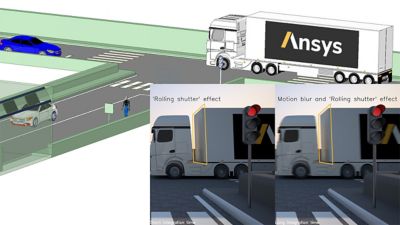-
-
학생용 무료 소프트웨어에 액세스하기
차세대 엔지니어에게 힘을 실어주는 Ansys
학생들은 세계적 수준의 시뮬레이션 소프트웨어를 무료로 이용할 수 있습니다.
-
지금 바로 Ansys에 연결하십시오!
미래를 설계하기
시뮬레이션이 다음 혁신을 어떻게 지원할 수 있는지 알아보려면 Ansys와 연결하십시오.
국가
무료 트라이얼
제품 및 서비스
학습하기
회사 정보
Back
제품 및 서비스
ANSYS BLOG
August 3, 2022
See Optical Simulation in a New Light with the Latest Ansys Speos Release
From the automotive industry to consumer electronics, optical design has become even more critical to overall product design as technology advances and demands increase to illuminate everyday designs from head-up displays (HUDs) to smart phones.
Ansys Speos optical system design software predicts the illumination and optical performance of systems to save on prototyping time and costs while improving product efficiency — but that’s not all.
In its latest release, Speos delivers powerful new capabilities that accelerate, improve, and expand optical simulation even further, including computer-aided design (CAD) integration, multi-graphics processing unit (GPU) compute, optimization, and more.

What’s New with Ansys Speos 2022 R2?
Speos delivers an intuitive user interface in a 3D platform for a fully immersive design experience, enhanced productivity with the use of GPUs for acceleration and simulation previews, and easy access to the Ansys multiphysics ecosystem.
With GPU compute, Speos accelerates high-performance computing (HPC) and reduces simulation time while achieving high scalability. Expanding upon this capability, Speos 2022 R2 supports multi-GPU and multi-node deployment. This means you can enable multiple GPUs per node and the more GPUs you use, the faster your simulation will compute. For reference, one GPU is approximately eight times faster than a 32-core central processing unit (CPU) and 20 GPUs are as fast as 5,000 CPU cores.
Coupled with this, dynamic effects in camera simulation are now fully compatible with GPU compute, including v2.0 distortion files and support parameters such as integration and lag time.
Further, with Speos 2022 R2 productivity enhancements, you can speed up the design process, improve accuracy, and achieve results even faster.
Top Speos 2022 R2 productivity enhancements include:
- Associative CAD connection: You can link with CAD data more powerfully using a bi-directional link that eases your workflow and shortens the design iteration cycle. Now when you modify parameters in Speos, the updates will apply to your Speos design and automatically occur in CAD while maintaining all links to Speos features.
- Auto-optimization: You can save engineering time by automatically designing a lens shape using embedded optimization. Speos 2022 R2 freeform lens enhancements add 2D illuminance targets to freeform lenses and automatically creates the back face of a lens to achieve specific beam patterns, which helps lighting designers create custom light patterns and control light pollution.
Other Productivity Enhancements
- Light field simulation and compatibility.
- Improved meshing control with geometries meshed proportionally to each lens’ face size.
- Easier stray light analysis and hot spot detection.
- Labs enhancement, which enables immediate access to key optical metrics.
- Increase the number of optical rays in your model to remove noise from your simulation results.
- Consider weather conditions at night for sensor validation in open loop.
- Simulate any stray light effect — even those coming from exotic optical fibers with complex cross-section sequences.
Integration with other Ansys products is also more seamless with the latest release. For example, you can easily connect with Ansys Mechanical through new capabilities that enable you to analyze and automatically simulate the mechanical deformation impact on optical performance — a unique Ansys capability. Similarly, with Speos 2022 R2, you can enable multiple Speos instances in other applications to simplify design optimization, including one instance for nominal design and one for deformed simulation.
You can also expand your multiphysics workflow through the Ansys Workbench simulation integration platform, which connects you with additional Ansys products. Alternatively, to go beyond your desktop or local cluster, you can pair Speos with Ansys Cloud to complete your simulations up to 60 times faster using cloud-based HPC.
Lighting the Way
Whether you need to enhance an automotive HUD or improve the illumination system design of a smart phone or light-emitting diode (LED) lighting source, Speos is an optical simulation solution for optimizing and validating any lighting system or optical sensor. Applications for Speos range from general lighting designs of rooms and streets to advanced automotive applications like glare-free high-beam headlamps and car body sensor integration.
In addition to its latest capabilities, Speos hosts a suite of built-in features including, lighting system modeler, lighting system analyzer, robust design optimization, optical part design, an extensive optical library (with more than 4,200 samples of lights and materials), and a human vision component that enables you to simulate visual predictions based on physiological human vision modeling.
To learn more about the latest features in Speos, register for the upcoming webinar: Ansys 2022 R2: What's New in Ansys Speos.